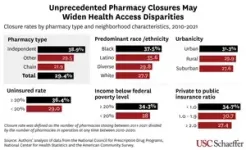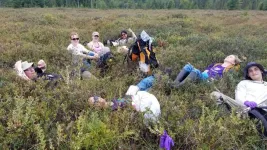(Press-News.org)
(MEMPHIS, Tenn. – December 3, 2024) Early disease detection is beneficial for securing the best possible outcomes for patients. But finding noninvasive, effective ways to predict disease risk is a tremendous challenge. Findings from scientists at St. Jude Children’s Research Hospital are showing promise for assessing cardiomyopathy risk in childhood cancer survivors. Heart disease is a well-established late effect for pediatric cancer survivors treated with anthracycline chemotherapy. The researchers identified a panel of 27 proteins as biomarkers of cardiomyopathy risk when measured in blood serum. The study, which used data from the St. Jude Lifetime Cohort (St. Jude LIFE), accurately predicted risk in 38 of 46 survivors, half with and half without cardiomyopathy. The findings were published today in JACC: CardioOncology.
While highly effective for the treatment of solid and hematological pediatric cancers, anthracycline chemotherapy drugs such as doxorubicin are well-known to increase the risk of cardiomyopathy — heart muscle disease. Patients who receive anthracycline treatment can expect a two-to-five-time higher chance of developing heart disease with five-year survival rates of less than 50% after diagnosis. Current methods used to assess cardiomyopathy risk in survivors, such as routine echocardiograms, are less effective for early detection, with diagnosis usually occurring past the point of curative treatment.
Recognizing the need for an accurate and affordable prediction tool for cardiomyopathy, Yadav Sapkota, PhD, St. Jude Department of Epidemiology & Cancer Control, sought to leverage the routine blood test. “We already measure proteins in regular lab tests, so this test, using circulating biomarkers, can be done as easily — a simple blood sample is all that’s needed.”
“The goal is to more accurately identify asymptomatic people who are more likely to develop cardiomyopathy as they become survivors of childhood cancer and then grow into adulthood,” he added.
A robust panel to detect preclinical cardiomyopathy
Sapkota’s team examined participants of the St. Jude LIFE cohort. This ongoing study aims to comprehensively document the lifetime impact of pediatric cancer through retrospective and prospective data collection and analysis. The researchers matched 98 survivors with cardiomyopathy with a comparable cardiomyopathy-free group.
The goal was to identify “subclinical” cases of cardiomyopathy before symptoms arise. “Seventy-five of our samples presented with cardiomyopathy, but they didn’t have symptoms — what we call subclinical based on reduced heart function,” Sapkota explained. “We looked into over 800 proteins in those patients who didn’t have symptoms yet, and we found 27 proteins that were differentially expressed in that group.”
The team investigated if this subset of proteins could be used to predict the risk of severe disease in an independent sample of survivors. “If we can use those proteins to predict who is likely to develop severe outcomes, we can then go back to asymptomatic patients or even those who don’t have any reduced cardiac function and make a prediction if this person is likely to develop severe outcome down the road.”
Based on the pilot study, the expansion of the research is ongoing. “The plan is to assess circulating biomarkers for everybody in St. Jude LIFE — almost 5,000 individuals,” Sapkota said. “And while cardiomyopathy is something we started on, we aim to evaluate other outcomes, such as diabetes, second cancers and many others. It’s going to be a great resource.”
Authors and funding
The study’s first author is Suresh Poudel, St. Jude. The study’s other authors are Cindy Im, University of Minnesota; Paul Burridge, Northwestern University; Smita Bhatia, University of Alabama at Birmingham; John Jefferies, University of Tennessee Health Science Center; Bonnie Ky, University of Pennsylvania; and Him Shrestha, Yue Pan, Qian Li, Kendrick Li, Stephanie Dixon, Matthew Erhardt, Daniel Mulrooney, Suiping Zhou, Haiyan Tan, Anthony High, Kirsten Ness, Melissa Hudson, Leslie Robinson, Gregory Armstrong, Junmin Peng and Yutaka Yasui, St. Jude.
The study was supported by grants from the National Cancer Institute at the National Institutes of Health (R01 CA261898, R01 CA216354, R21 CA261833, U24 CA55727, U01 CA195547, Cancer Center Support [CORE] Grant CA21765), and ALSAC, the fundraising and awareness organization of St. Jude.
St. Jude Media Relations Contacts
Chelsea Bryant
Desk: (901) 595-0564
Cell: (256) 244-2048
chelsea.bryant@stjude.org
media@stjude.org
Rae Lyn Hartley
Desk: (901) 595-4419
Cell: (901) 686-2597
raelyn.hartley@stjude.org
media@stjude.org
St. Jude Children’s Research Hospital
St. Jude Children’s Research Hospital is leading the way the world understands, treats and cures childhood cancer, sickle cell disease and other life-threatening disorders. It is the only National Cancer Institute-designated Comprehensive Cancer Center devoted solely to children. Treatments developed at St. Jude have helped push the overall childhood cancer survival rate from 20% to 80% since the hospital opened more than 60 years ago. St. Jude shares the breakthroughs it makes to help doctors and researchers at local hospitals and cancer centers around the world improve the quality of treatment and care for even more children. To learn more, visit stjude.org, read Progress: A Digital Magazine and follow St. Jude on social media at @stjuderesearch.
END
COLCHESTER, VT – Researchers from Saint Michael’s College and the University of Vermont have made a groundbreaking new discovery that provides a better understanding of how Alzheimer’s disease develops in the human brain.
Guided by previous research of spider brains, the scientists uncovered evidence of a “waste canal system” in the human brain that internalizes waste from healthy neurons. They discovered that this system can undergo catastrophic swelling, which leads to the degeneration of brain tissue, a hallmark of Alzheimer’s disease.
With over 50 million affected people worldwide, Alzheimer’s ...
Key study findings:
The rate of pharmacy store closures in recent years has more than doubled, affecting about 1 in 3 pharmacies between 2010 and 2021 and contributing to an unprecedented decline in the availability of pharmacies in the U.S
About one-third of counties experienced an overall decline in pharmacies, and the risk of closure was higher in predominantly Black and Latino neighborhoods.
Independent pharmacies, often excluded from networks by pharmacy benefit managers, were more than twice as likely to face closure compared to chain pharmacies.
Policymakers should consider several ...
The University of Alaska Fairbanks released a new report this week highlighting environmental changes and extremes that impact Alaskans and their livelihoods.
“Alaska’s Changing Environment” provides people with timely, reliable and understandable information on topics ranging from temperature and precipitation changes to salmon and polar bears.
The report was led by the Alaska Center for Climate Assessment and Policy at the UAF International Arctic Research Center, with contributions from more ...
East Hanover, NJ – December 3, 2024 – Veterans with disabilities continue to outperform the general population of people with disabilities in employment rates, highlighting the possible impact of specialized training and participation in essential industries, according to a new analysis shared during a National Trends in Disability Employment (nTIDE) Deeper Dive Lunch & Learn Webinar held on November 22. nTIDE is a joint effort by Kessler Foundation and the University of New Hampshire’s Institute on Disability (UNH-IOD).
Despite ...
It might seem out of place on the side of a highway, but purpose-built exercise equipment installed at truck stops across Australia could be just the thing to encourage truck drivers to take a break and take control of their health and wellbeing.
In the first meta-analysis of how health behaviour interventions can affect truck drivers, researchers at the University of South Australia have found that tailored, multi-level and innovative approaches to truck driver health are required to enact positive change, as current interventions are not working.
Reviewing the effectiveness of health interventions for more than 2000 truck drivers across 19 studies, researchers found ...
Treatment for more advanced and difficult-to-treat head and neck cancers can be improved with the addition of polyvinyl alcohol (PVA), the same ingredient used in children’s glue. Researchers found that combining PVA with a boron-containing compound, D-BPA, improved the effects of a type of radiation therapy for cancer, compared to currently clinically used drugs. The PVA made the drug more selective of tumor cells and prolonged drug retention, helping to spare healthy cells from unnecessary radiation damage.
Japan became the first country to approve boron neutron capture therapy (BNCT), a type of targeted radiotherapy for cancer, in 2020. Doctors ...
Materials scientist Prof Dr Oana Cojocaru-Mirédin of the University of Freiburg has been awarded a Consolidator Grant from the European Research Council (ERC). With this grant, the European Union (EU) is funding her research project on the properties of what are known as grain boundaries in crystalline materials, such as those used for solar cells. The grant is among the most prestigious funding programmes for scientists in the EU. It provides almost two million euros for a five-year period. This ...
An analysis of fungi collected from peat bogs has identified several species that produce substances toxic to the bacterium that causes the human disease tuberculosis. The findings suggest that one promising direction for development of better treatments might be to target biological processes in the bacterium that help maintain levels of compounds known as thiols. Neha Malhotra of the National Institutes of Health, U.S., and colleagues present these findings December 3rd in the open-access journal PLOS Biology.
Every year, millions of people around the world fall ill from tuberculosis and more than 1 million ...
Evaluating the speed at which viruses spread and transmit across host populations is critical to mitigating disease outbreaks. A study published December 3rd in PLOS Biology by Simon Dellicour at the University of Brussels (ULB), Belgium, and colleagues evaluate the performance of statistics measuring how viruses move across space and time in infected populations.
Genomic sequencing allows epidemiologists to examine the evolutionary history of pathogenic outbreaks and track the spatial movement of an outbreak. However, the sampling intensity of genomic sequences can potentially impact the accuracy of dispersal insights gained through these evolutionary ...
Baltimore, Maryland (Dec. 3, 2024) — The Lieber Institute for Brain Development has been selected as a winner of the 2024 Amazon Web Services (AWS) IMAGINE Grant, a public grant opportunity open to registered charities in the United Kingdom and Ireland and registered 501(c) nonprofit organizations in the United States who are using technology to solve the world’s most pressing challenges. The Lieber Institute, located on the Johns Hopkins medical campus in Baltimore, will use the grant to develop a new generative AI tool to find new, more effective treatments for mental illnesses including schizophrenia.
Now ...







